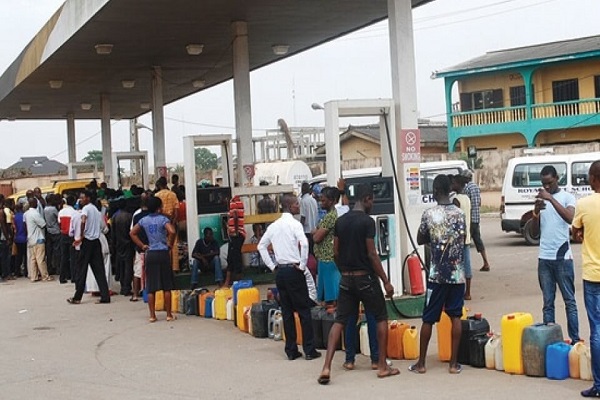- Govt must address the lingering fuel scarcity by fixing distribution networks and ensure local refineries work
Last week, Nigerians were again forced to wonder whether the cycle of spasms in the fuel supply chain would ever end. It started with fuel queues suddenly springing up in the Federal Capital Territory (FCT), Abuja, penultimate weekend. Days after, it spread to the nation’s commercial capital, Lagos, and some parts of the southwest, and then some other parts of the country.
From FCT to Minna, the Niger State capital, where major outlets did not open, with minor players filling the gaps
with their exploitative play, to Kano where majority of the filling stations, particularly those owned by major marketers were shut down, or Akure, the Ondo State capital, where petrol price reportedly hit N750 per litre down to Lagos where panic nearly became the order, motorists’ anxieties were palpable, especially with no credible explanations coming forth.
There were of course silent whispers about “adverse weather conditions” and “logistics” being at the heart of it all. On his part however, the national president of the Petroleum Products Retail Outlets Owners Association of Nigeria (PETROAN) –Billy Gillis-Harry – would put the problem to the inability of his members to source petrol from NNPCL as in his words – ‘the only source from which his members lift the product is the NNPCL and so when there is no fuel, it means the state-owned oil firm has not supplied’.
The much that his Independent Petroleum Marketers Association of Nigeria (IPMAN) counterpart, Abubakar Maigandi, could say was that “Loading is very slow at the depots”.
The bottom-line: there was insufficient product to go round.
So much for the supposed transformation of the national oil corporation; Nigerians cannot but wonder if truly anything has changed between the old NNPC and the NNPCL. And what could be new outside of those factors that Nigerians and the government are already aware? Thunderstorms? How? NNPCL surely owes Nigerians more explanations than it has managed to put out.
What is apparent is that the NNPCL, even after its so-called transition to a commercial entity, is yet to understand its rationale as a provider of a critical service, one in which failure continues to exert unimaginable tolls on the Nigerian economy, both in terms of the massive disruptions of businesses and, more particularly, in the man-hours lost by motorists on fuel queues. That the corporation remains hung on the archaic business-as-usual model which
has proven disastrous time and time again is most regrettable. Years after its transition; when are we going to see the corporation begin to push aggressively towards the realisation of the lofty ideals of the Petroleum Industry Act (PIA)?
We have said it before: the problems in the downstream persist because the nation’s four refineries and the allied distribution infrastructure are not working. They are not working because those charged with the duty of getting them to work are yet to demonstrate the needed resolve to make the difference.
Take the refineries for instance. Based on its initial promise, the Port Harcourt Refinery ought to have come on-stream by December 31, 2023. Some six months after it announced its ‘mechanical completion’, Nigerians are still at a loss on what to make of the announcement, particularly with no guarantees of the refinery releasing refined products into the market anytime soon.
The same applies to Warri and the Kaduna refineries, all of whose turn around maintenance was initially scheduled to be completed by year-end. It has been excuses and more excuses, with no signs of the NNPCL ever delivering on its promise. Even the long-awaited entry of Dangote Refinery into the segment has proven to be something of a damp squib.
Important as it is, the fact is that getting the refineries up and running is only one half of the fuel supply equation. Even when the refineries eventually come on-stream, the country will still have to contend with the obsolete fuel distribution infrastructure. Whether it is System 2E (Port Harcourt to Aba), System 2D (Kaduna to Kano) or System 2B (Atlas Cove to Mosimi to Ore depot and from Ibadan to Ilorin depot and then Suleija), none of the pipelines network which the country has invested billions of naira to build is in any shape to receive, let alone transport fuel. While most have been vandalised by criminal elements, the rest have been left to rot under the NNPCL’s regime of institutional indifference. As it does appear, the owners of the operating entity – the Pipelines and Products Marketing Company Limited (PPMC) – seems to have long given up on their possible restoration.
These are the issues behind the perennial hiccups. Getting the local refineries up and running means that the NNPCL will have no further excuses about the crippling forex issues, import cycle delays, and missed turnaround delivery timelines. With functional pipelines network, Nigerians will be spared the perennial rationalisations about the factors of logistics and adverse weather conditions playing any significant role in the fuel distribution mix. It is precisely why Nigerians have long said that they cannot wait to have the NNPCL deliver on them.
If merely for their manifold benefits to the economy which are unquantifiable, government’s assistance in getting those pipelines in particular restored in the quickest possible time will surely be worth the sacrifice. With the government’s avowed resolve to re-write the nation’s energy narrative, it seems to us that there can be no better time than now to slay the twin dragons of non-functional refineries and obsolete pipelines that have kept the segment of the industry down.

